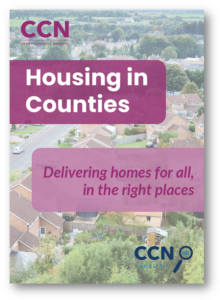
CCN Latest News, CCN News 2024 | 23 March 2024

The new research from the County Councils Network shows that the number of households in private and social rent has increased by over half a million in county and rural areas over the last decade, outpacing the increase in renting in London and the country’s other major cities.
 Seen as the traditional location of home ownership, shire counties have seen a decrease in people purchasing homes over the last ten years, with house prices locking more and more people out of ownership. This has led to more people entering the rental market, including those in social rented accommodation – adding to pressure on local housing.
Seen as the traditional location of home ownership, shire counties have seen a decrease in people purchasing homes over the last ten years, with house prices locking more and more people out of ownership. This has led to more people entering the rental market, including those in social rented accommodation – adding to pressure on local housing.
Download Housing in Counties here.
Warning that the planning system is a ‘state of flux’, councils are calling for the next government to set out a long-term plan for housing. This should include a renewed emphasis on delivering homes of all tenures, a greater focus on social housing, and a review of key policy areas, such as Right to Buy. In the short-term, the government should also pass the Renters’ Reform Bill as soon as possible to give extra protection to renters.
The report provides a ten year long deep-dive into housing trends into 38 county and rural areas which home 25m people in England, and finds:
The report argues that despite best intentions, constant tinkering of the planning system over the last decade has led to unstable and un-coordinated planning system for local authorities to work with. With a general election expected to take place this year, councils are calling for stability and for the next administration to set out a long-term plan for housing, with local government a key player in discussions.
This long-term plan should include increasing housing delivery of all tenures, with the report finding that schemes such as Help to Buy and First Homes have led to a less properties for social rent being built than otherwise would have been. Therefore, both these policies should be reviewed.
The report recommends that any future national planning policy should promote the delivery of homes all tenures, rather than a focus on houses. This is especially true for large sites, which are more prevalent in county locations and city outskirts.
Councils should also give autonomy to local councils to set their own thresholds and types of affordable housing that are most needed in their area as part of their Local Plans, in recognition that different areas have differing needs.
The study also recommends that the next government introduces ‘strategic planning’ back into the system. This would bring together both planning and infrastructure authorities in 20 county areas in England where both types of council co-exist, in order to collaboratively plan for housing, infrastructure and employment in tandem and across a wider area. The report suggests that such an approach would alleviate local concerns about overdevelopment and a dearth of infrastructure in some areas, further removing a blockage to housing delivery.
 Cllr Richard Clewer, Housing and Planning Spokesperson for the County Councils Network, said:
Cllr Richard Clewer, Housing and Planning Spokesperson for the County Councils Network, said:
“It is widely accepted that the housing crisis is one that is worsening, with rising unaffordability locking hundreds of thousands out of getting onto the property ladder. This new data reveals the impact of this in rural and county areas: with the rise in people renting in these places outpacing even London and the major cities, whilst home ownership rates have gone into decline.
“This growing unaffordability impacts on council services too, tipping more people onto local authority housing waiting lists, into homelessness, and into temporary accommodation where costs are increasingly becoming exorbitant.
“This report does not suggest that we alleviate these issues by concreting over our countryside. Instead it sets out a number of important yet easily deliverable recommendations that, taken together, could accelerate the delivery of new homes of all tenures where there is most need.
“These challenges are in part due to a planning system that has been in a state of flux for a long time. The next government should set out a long-term plan for housing, incorporating the recommendations we have put forward and with councils a key consultee, ensuring buy-in from the sector.”
Notes to editor
| Council type | Housing delivered
(Between 2018/19 and 2022/23 plus percentage increase) |
Average house prices
(as of November 2023) |
House prices to wages ratio | Increase households renting
(Between 2011-2021 plus percentage increase) |
Increase in households on council house waiting lists
(between 2018/19 – 2022/23 plus percentage increase) |
Increase in households in temporary accommodation (between 2018/19 – 2022/23 plus percentage increase) |
| County and unitary (CCN) | 606,100 (+28%) | £309,700 | 11.1 | 551,000 (+19%) | 40,000 (+10.4%) | 6,100 (+52%) |
| London | 184,000 (+21%) | £558,300 | 16.5 | 212,000 (+13.2%) | 80,300 (+33%) |
3,700 (+6.4%) |
| Metropolitan Borough | 200,400 (+29%) | £208,400 | 7.5 | 223,000 (+12.4%) | 9,500 (+2.8%) | 5,800 (+71%) |
| Unitary | 173,200 (+12%) | £272,600 | 9.4 | 196,000 (+14.8%) | -2,500 (-1.3%) | 3,900 (+44%) |
© 2024 County Councils Network | Credits | Site map | Cookies | Privacy Policy.